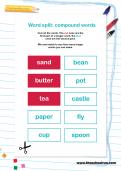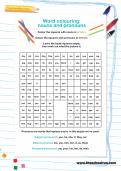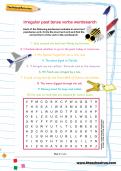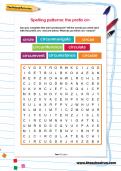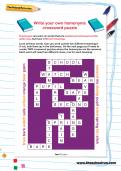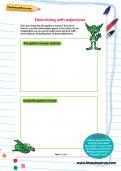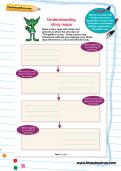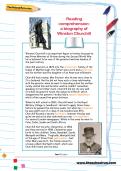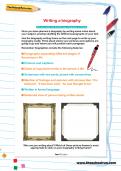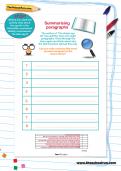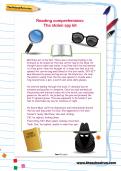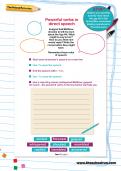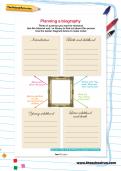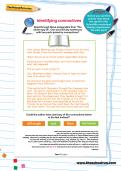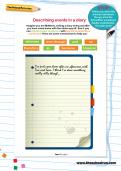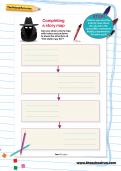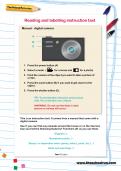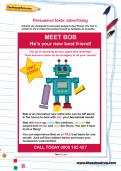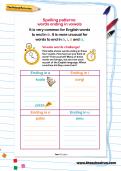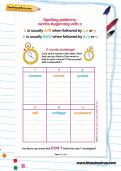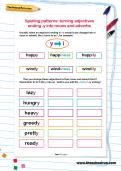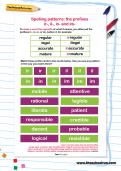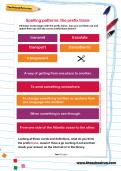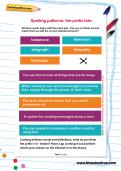Ks2 English worksheets
Free worksheets: Word puzzles, KS2
You’ll need to login or Register first to access these worksheets for free.
Once you’ve tried out our free worksheets, why not explore all our resources (1000s of worksheets, interactive tutorials, learning packs and more) with a 14-day FREE trial subscription.
Word split: compound words
A mix and match puzzle created by teachers, using compound words, to support primary school literacy and demonstrate examples of compound words.
Word colouring: nouns and pronouns
Colour the squares with nouns in green. Colour the squares with pronouns in brown. Leave the blank squares empty, then work out what the picture is.
Irregular past tense verbs wordsearch
A fun and free activity created by an experienced teacher with the aim of teaching KS2 children about irregular past tense verbs. Each of the sentences on the worksheet includes an incorrect past-tense verb. Circle the incorrect verb and then find the correct form of the verb in the wordsearch.
Spelling patterns: the prefix cir-
Can you complete this mini-wordsearch? All the words you need start with the prefix circ- and are below. What do you think circ- means?
Write your own homonyms crossword puzzle
Homonyms are pairs of words that are spelled and pronounced the same way, but have different meanings. Look at these words. Can you work out the two different meanings?
If not, look them up in the dictionary. On the next page you’ll need to create TWO crossword puzzles where the homonyms are the answers. Each word will need two different clues, one for each meaning.
If not, look them up in the dictionary. On the next page you’ll need to create TWO crossword puzzles where the homonyms are the answers. Each word will need two different clues, one for each meaning.
Describing with adjectives
Can you draw the the goblin’s house from the story The Goblin's Curse? You don’t have to use the information given in the story, be as imaginative as you want! Label each picture with descriptions, including lots of good adjectives.
Understanding story maps
Using a story map framework will help you organise your ideas about the text in a clear and efficient way. Can you draw a story map with notes and pictures to show the structure of ‘The goblin’s curse’?
Reading comprehension activity: biography of Winston Churchill
This KS2 reading comprehension activity was created by an experienced teacher to help build your primary-school child's comprehension strategies and skills.
Winston Churchill is an important figure in history because he was Prime Minister of Britain during the Second World War. Read this biography and then see if you can answer the questions.
Winston Churchill is an important figure in history because he was Prime Minister of Britain during the Second World War. Read this biography and then see if you can answer the questions.
Writing a biography
Use this biography writing frame to write a biography. Think about where your pictures and captions are going to go and where you will position each paragraph. Don't forget all the important features of a biography!
Summarising paragraphs
The author of ‘The stolen spy kit’ has split the story into eight paragraphs. Read through the story again and think about why the text has been split up this way. Can you write a phrase that sums up each paragraph in these boxes?
Reading comprehension: The stolen spy kit
Read this tense tale about a stolen spy kit and then see if you can answer the questions.
Powerful verbs in direct speech
Start by reading 'The stolen spy kit' then imagine that Matthew decides to tell his mum about the Spy Kit. What might he say to her? How do you think she would reply? Write the conversation they might
have. Remember the rules of speech!
have. Remember the rules of speech!
Planning a biography
Think of a person you want to research. Use the Internet and / or library to find out about this person. Use the spider diagram below to make notes about their birth, young adulthood, later adulthood and death.
Identifying connectives
Read through these paragraphs from ‘The stolen spy kit’. Can you find any sentences with two parts joined by connectives? Could the author have used any of the connectives below in the text instead?
Describing events in a diary
This worksheet accompanies the reading comprehension: 'The stolen spy kit'. Imagine you are Matthew, writing a diary entry just after you have come home with the stolen spy kit. See if you can include longer sentences with two parts joined by a connective.
Completing a story map
Complete the reading comprehension: 'The stolen spy kit'. The see if you can draw a story map with notes and pictures to show the structure of the story.
Reading and labelling instruction text
This is an instruction text. It comes from a manual that came with a digital camera. See if you can find any manuals around the house or on the internet. Can you find the following features? Tick them off as you see them.
Persuasive texts: advertising
A Year 5 (KS2) persuasive text example and activity, created by an experienced teacher and based on the use of persuasive texts in advertising.
Spelling patterns: words ending in vowels
It is very common for English words to end in e. It is more unusual for words to end in a, i, o and u. This table shows words ending in these four vowels. How fast can you think of more? Time yourself! Many of these words are foreign, but are now used as part of the English language. Which countries did they come from?
Spelling patterns: words beginning with c
The letter c is usually soft when followed by i, e or y but it is usually hard when followed by a, o or u. Look at the words in this table. How fast can you think of five more to add to each column? Time yourself with a stopwatch!
Spelling patterns: turning adjectives ending -y into nouns and adverbs
Usually, when an adjective ending in –y needs to be changed into a noun or adverb, the y turns to an i. Can you change these adjectives to their noun and adverb form? Remember to turn the y into an i before you add the -ness / -ly ending!
Spelling patterns: the prefixes ir-, il-, in- and im-
To make a word the opposite of what it means, you often put the prefixes ir-, il-, in- or im- before it. Match these prefix cards to the words below. Can you see any pattern in the way you match them?
Spelling patterns: the prefix trans-
All these words begin with the prefix trans-. Can you cut them out and match them up with the correct definitions below? Looking at these words and definitions, what do you think the prefix trans- means? Have a go working it out and then check your answer on the internet or in the library
Spelling patterns: the prefix tele-
All these words begin with the prefix tele-. Can you cut them out and match them up with the correct definitions below?
Spelling patterns: the prefix cir-
Can you complete this mini-wordsearch? All the words you need start with the prefix circ- and are below. What do you think circ- means?
